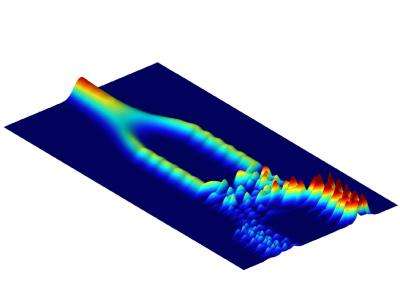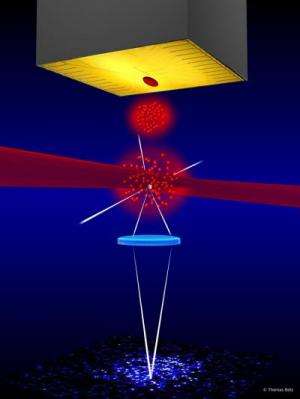Improving measurements by reducing quantum noise

If you want to measure something very precisely, such as slight variations of a length, then you are very likely to use light waves. However, many effects, such as variations of gravity, or surface forces, can only be measured using particles that have a mass. Since, according to the rules of quantum mechanics, massive particles also behave like waves, interferometers can be built in which single atoms or even entire atomic clouds are used instead of light.
A team from the Vienna University of Technology has now been able to develop a Mach-Zehnder interferometer for Bose-Einstein condensates containing about a thousand atoms trapped by an atom chip. Using the interactions between the atoms, they were able to strongly reduce the quantum noise, which sets the best achievable sensitivity. This resulted in multiplying the measurement time by three and significantly improving the precision of the measurement.
Mach-Zehnder interferometer for ultracold atomic clouds
The team of Professor Jörg Schmiedmayer (Vienna Center for Quantum Science and Technology – VCQ, Atominstitut, TU-Wien) has taken up the idea of the Mach-Zehnder interferometer and adapted it for trapped atoms on an atom chip. The Mach-Zehnder interferometer is an interferometric setup in which a wave is split into two halves on a first beam splitter and then recombined. From the way the two beams interfere, the magnitude of the interaction acting on the particles can be read out very accurately. It's according to this principle that the first matter-wave interferometry experiments with separated beams were performed in 1974 at the reactor of the Atominstitut, using neutrons.
Instead of single particles, the team at the TU Vienna has now been using entire atomic clouds. At ultralow temperatures, close to absolute zero, atoms lose their individuality and "clump" into a single quantum object – the Bose-Einstein condensate. "In such a condensate, all atoms form a single quantum wave, exactly as photons in a laser behave quantum mechanically all together", Jörg Schmiedmayer explains.
In usual atom interferometers, the atoms move freely, and the measurement time is limited by the time of flight. In the new interferometer at the TU Vienna, the Bose-Einstein condensate is held in a trap during the whole sequence, which in principle would set no limit to the interrogation time.

Shot noise responsible for imprecision
"Atom interferometers are widely used for high precision measurements. But besides the technical hurdles that have to be overcome, the precision of an interferometer also has fundamental limits." explains Tarik Berrada, first author of the paper recently published in the scientific journal "Nature Communications".
Usually, the precision of an interferometer is limited by the so-called "shot noise". It is due to the fact that a quantum beam is not a continuous stream but is made out of discrete particles. When rain drops are falling on a tin roof, one hears a "dripping" noise, while a continuous flow of water would cause a uniform roar.
When an atomic cloud is split in two parts, shot noise causes an uncertainty in the atom number on each side: while the atoms are in a quantum superposition of atoms being left and right at the same time, the atom number difference between the two parts exhibits quantum fluctuations. "Through atomic interactions, the uncertainty on the atom number is converted into an uncertainty on the quantum phase", Tarik Berrada explains. The noise on the quantum phase – the beat at which the quantum superposition ticks – grows, limiting in turn the precision of an interferometric measurement.
However, in the experiment at the TU Vienna, the condensates are prepared in a particular quantum state: "Using a so called squeezed state, in which the atoms are strongly entangled with each other, we are able to reduce the uncertainty on the atom number difference below the shot noise limit", Jörg Schmiedmayer says. With this technique, the precision of a measurement would eventually be limited by the Heisenberg uncertainty principle only, which sets the ultimate precision boundary allowed by quantum mechanics.
Tiny energy differences measurable
The measurement of an energy difference demonstrates how powerful the method is: after splitting a Bose-Einstein condensate, one half of the cloud is lifted by about 100 nm with respect to the other. This way, the upper part has a bit more gravitational potential energy. Even for this small difference in height, it can be precisely measured using the interferometer. Although such a precision can already be achieved by other interferometric methods, reducing the quantum noise will allow further improvement in the accuracy of measurements using Bose-Einstein condensates.
"The main difficulty was to develop counterparts to the components of an optical Mach-Zehnder interferometer", Tarik Berrada says. This was implemented using an atom chip to generate the magnetic double-well potentials used to precisely control and manipulate the atomic clouds. For instance, in an optical interferometer, the beams are recombined by being overlapped on a half-silvered mirror. In the experiment at TU Vienna, the Bose-Einstein condensates are literally "thrown" on a precisely tunable magnetic potential barrier.
Journal information: Nature Communications
Provided by Vienna University of Technology




















